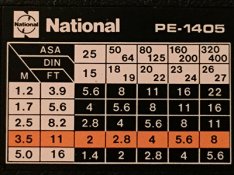I checked in the manual and found this info.
Guide no:
14 ISO 100 color/m
10 ISO 50 color/m
23 ISO 25 color/ft
Automatic operating range:
Distance 1-3,5m
Aperture f4 for ISO 100 / f2.8 for ISO 50
In other words, the auto mode cuts off when it has seen sufficient light to correctly expose a 100 ISO film at f/4, or a 50 ISO film at f/2.8, which requires the same amount of light. This light level is "baked in" to the flash.
A weak flash in other words. The flash does have a cable that connects to the M6TTL's terminal below so it can be removed from the hot shoe and still fire (there's no swivel head).
The lack of a swivel head means it will be hard to use for bounce. Even if you remove from the hotshoe and point it at the ceiling, you want the flash's light sensor to be pointed at the subject, not the reflector, to use for bounce flash in auto mode. So you could only bounce in manual mode, which will be a PITA unless yu use a flash meter.
As I understand it, on this flash the difference between the auto and manual modes is only that in auto the flash will cut off the flash when the tyristor senses that enough flash has been provided. In manual mode the cut off is done (so to speak; I mean, from the perspective of the film's exposure) by me by setting the aperture. Would this be approximately right?
Correct. In manual mode it just flashes at full power. In your original post you mentioned that manual mode is activated by mechanically covering the light sensor This simply prevents it from ever seeing "enough flash".
It is a bit confusing that there is no way to tell the flash the ISO of the film. I take this to mean that there isn't really an auto mode.
The auto mode cuts off after a certain amount of light has been seen. You can't adjust the cut-off threshold. All you can do is adjust the aperture so that this is the correct amount of light for the film EI/ISO. However this can still effectively compensate for subject distance and reflectivity.
The manual says that in auto one follows the orange line in the chart - and presumably ignores the fact that it says distance 3,5 m - but ignoring the distance must mean that the flash will give flawed results at other distances, at least if one uses the flash as main source of illumination (which I am not interested in).
3.5m is the
maximum distance on auto. It should automatically compensate for closer subject distances by cutting the flash off earlier. Close down the aperture 1-2 stops more for use as fill flash, e.g. by using f/5.6 instead of f/4 for 100 ISO at 3.5m.
In the street scenario, if I shoot Velvia 100 and the camera's meter tells me the scene is approximately f8 at 1/125 for a correctly exposed photo that would mean f11 at the 1/50 sync speed of the M6TTL (of course, 1/50 is quite slow and risks a bit of blur, but I'm ok with that). So far so good for the ambient exposure.
If I shoot in manual mode and my primary subject is 2m away, then based on GN 14 I should set an aperture of about f7 for correct exposure with the flash as only source. This seems to be what the chart says too; at 1,7m f8 so f7 at 2m seems right. One stop less for fill would mean shooting at f5.6. Now the discrepancy between the ambient exposure's f11 and the flash exposure's f5.6 is two stops. What would happen if I add a 3-stop ND filter? Would I still benefit from the fill flash?
For fill you have to
reduce the flash exposure, which means reducing the aperture (i.e. increasing the f-number). So if the flash calculation says f/7, you need to be at about f/11. This happens to be the same as the ambient exposure, so you're good. If the flash exposure and ambient require different apertures, then you
may be able to get them to use the same aperture by adjusting your shutter speed, since this affects only the ambient exposure, not the flash exposure. However with the M6 the slow flash sync speed is a real problem - you can't use a shutter speed faster than 1/50" and camera shake means you don't want a shutter speed much slower than 1/50". This is really not a good combo with such an inflexible flash unit. You will find it much easier if you get either a manual flash that allows you to control the output, an auto flash that allows you to program in the camera's aperture (meaning you can adjust the flash to match the aperture required for the ambient exposure; remember to program in that the aperture is one stop larger than it actually is to reduce the flash by 1 EV for fill), or a Leica compatible TTL flash (presuming that either it or the camera has some way to adjust flash exposure comp for fill).
You can't use an ND filter to balance ambient and flash as it will reduce both the flash and the ambient by the same amount, leaving the balance unchanged.



